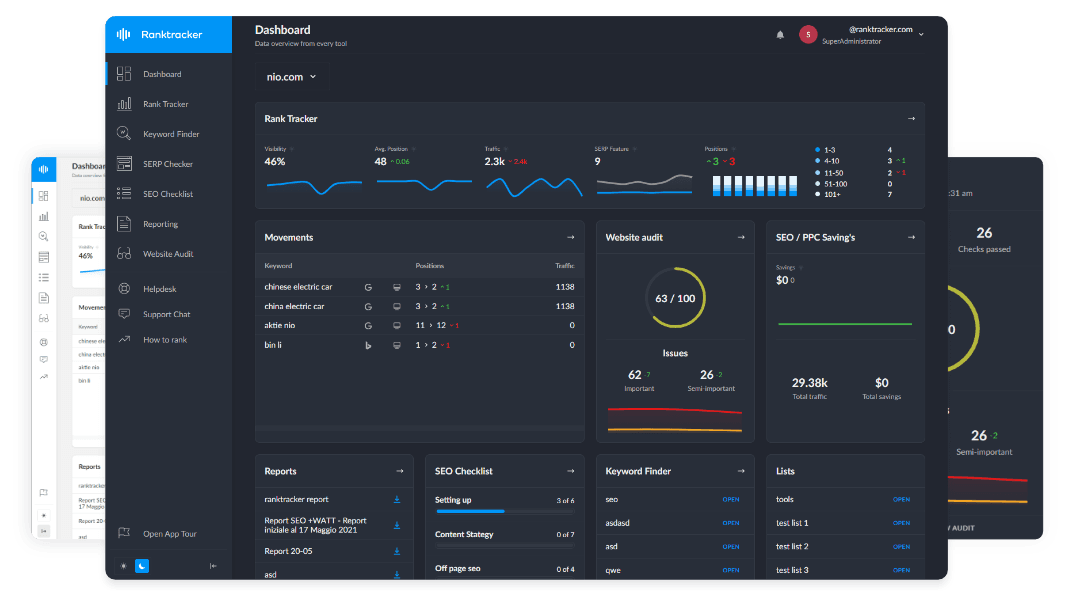Intro
Technical SEO refers to optimizing a website’s infrastructure, performance, and crawlability to improve search engine rankings. It ensures that search engines can efficiently crawl, index, and interpret website content.
Why Technical SEO Matters:
- Enhances search engine accessibility & indexing.
- Improves website performance & user experience.
- Strengthens security, structure, and crawl efficiency.
Key Elements of Technical SEO
1. Website Crawling & Indexing Optimization
- Ensure search engines can access and understand your site.
- Tools:
- Google Search Console – Check crawl errors.
- Ranktracker’s Web Audit Tool – Identify technical issues.
2. XML Sitemap Optimization
- Keep sitemaps clean, updated, and well-structured.
- Example:
<urlset xmlns="http://www.sitemaps.org/schemas/sitemap/0.9">
<url>
<loc>https://example.com/page1/</loc>
<lastmod>2024-03-11</lastmod>
<priority>0.8</priority>
</url>
</urlset>
3. Robots.txt for Search Engine Directives
- Manage which pages should or shouldn’t be crawled.
- Example:
User-agent: *
Disallow: /private/
Allow: /public/
4. Website Speed & Core Web Vitals
- Optimize page speed, LCP, CLS, and FID.
- Tools:
- Google PageSpeed Insights – Measures site performance.
- GTmetrix – Identifies speed bottlenecks.
5. Mobile-Friendliness & Responsive Design
- Ensure a mobile-first experience for better rankings.
- Use Google’s Mobile-Friendly Test tool.
6. Structured Data & Schema Markup
- Implement Schema.org markup for better rich results.
- Example:
{
"@context": "https://schema.org",
"@type": "Article",
"headline": "Technical SEO Guide",
"author": "SEO Expert",
"publisher": {
"@type": "Organization",
"name": "SEO Hub"
}
}
7. Canonical Tags & URL Optimization
- Prevent duplicate content issues with proper canonicalization.
- Example:
<link rel="canonical" href="https://example.com/original-page/">
8. HTTPS & Security Enhancements
- Ensure your website uses SSL (HTTPS) for security.
- Example:
Redirect HTTP to HTTPS using a 301 redirect:
Redirect 301 / https://example.com/
9. Internal Linking & Crawl Budget Optimization
- Use strategic internal linking to help search engines discover content.
- Example:
<a href="/technical-seo-guide/">Read our Technical SEO Guide</a>
Best Practices for Optimizing Technical SEO
✅ 1. Perform Regular Technical SEO Audits
- Use Google Search Console, Screaming Frog, and Ranktracker’s Web Audit Tool.
✅ 2. Optimize for Core Web Vitals
- Focus on page load speed, interactivity, and visual stability.
✅ 3. Keep URLs Clean & SEO-Friendly
- Use short, descriptive, and keyword-rich URLs.
✅ 4. Fix Broken Links & Redirect Issues
- Use 301 redirects for outdated pages.
✅ 5. Ensure a Mobile-First Experience
- Test responsive design and mobile usability.
Tools to Improve Technical SEO
- Google Search Console – Monitor indexing and crawl stats.
- Ranktracker’s Web Audit Tool – Identify technical SEO gaps.
- Screaming Frog SEO Spider – Analyze site structure and crawlability.
Conclusion: Strengthening Your SEO Foundation
A well-optimized technical SEO strategy ensures better indexing, search performance, and user experience. By improving website speed, crawlability, security, and structured data, websites can maximize SEO rankings and visibility.

